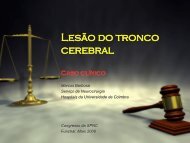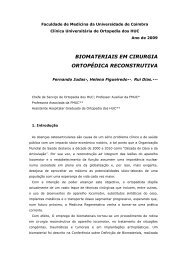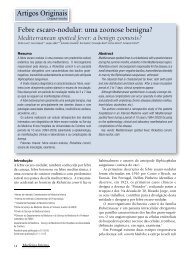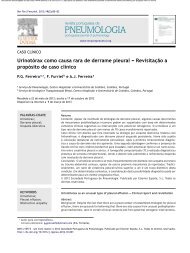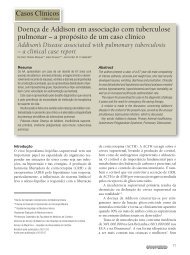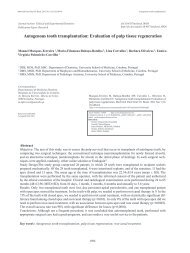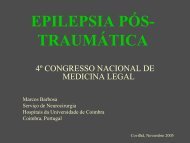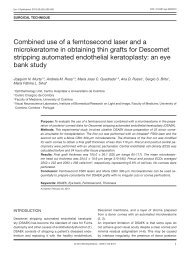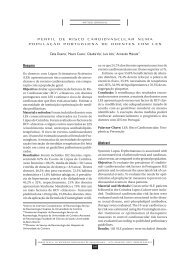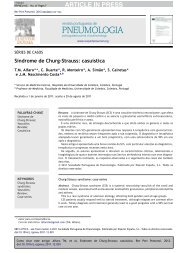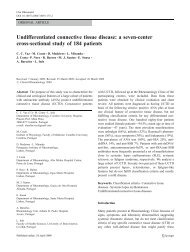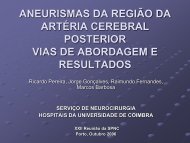Doxorubicin versus doxorubicin and cisplatin in endometrial ...
Doxorubicin versus doxorubicin and cisplatin in endometrial ...
Doxorubicin versus doxorubicin and cisplatin in endometrial ...
Create successful ePaper yourself
Turn your PDF publications into a flip-book with our unique Google optimized e-Paper software.
443<br />
diameter of all evaluable lesions, as determ<strong>in</strong>ed by two observations not less<br />
than 4 weeks apart, without progression or new lesions. There also had to be<br />
an objective improvement <strong>in</strong> non-evaluable but cl<strong>in</strong>ically evident malignant<br />
disease, <strong>and</strong> no <strong>in</strong>crease of any manifestations of malignant disease. No<br />
change was def<strong>in</strong>ed as a reduction of less than 50%, or an <strong>in</strong>crease of less than<br />
25%, <strong>in</strong> the size of one or more measurable lesions, without evidence of either<br />
new lesions or an <strong>in</strong>crease <strong>in</strong> any manifestation of malignant disease, until the<br />
first evaluation date. Progression of disease was def<strong>in</strong>ed as an <strong>in</strong>crease of<br />
greater than 25% <strong>in</strong> the size of one or more measurable lesions, or the appearance<br />
of a new lesion, <strong>and</strong> also by the occurrence of positive cytology of pleural<br />
effusion or ascitic fluid. Early progressive disease was def<strong>in</strong>ed as<br />
progression that occurred after one cycle. Early tumour death was def<strong>in</strong>ed as<br />
death occurr<strong>in</strong>g dur<strong>in</strong>g the first 8 weeks due to tumour progression, whilst<br />
toxic death was def<strong>in</strong>ed as death to which drug toxicity was thought to have<br />
made a major contribution.<br />
Statistical considerations<br />
The trial was designed as a r<strong>and</strong>omised phase II trial to be extended <strong>in</strong>to a<br />
comparative phase III trial <strong>in</strong> the case of sufficient responses. The phase II<br />
part of the trial required a m<strong>in</strong>imum of 20 patients <strong>in</strong> each arm, with five<br />
patients to be added per each response observed dur<strong>in</strong>g the first step. With<br />
respect to the comparative phase III part of the trial, it was assumed that the<br />
median duration of survival <strong>in</strong> the control (DOX) arm would be 8 months, <strong>and</strong><br />
the addition of CDDP would be justified if it could <strong>in</strong>crease the median duration<br />
of survival to 1 year. A total of 192 deaths were required to detect such a<br />
difference, with a two-sided type I error of 0.05 <strong>and</strong> a power of 80% [8]. Dur<strong>in</strong>g<br />
r<strong>and</strong>omisation, patients were stratified accord<strong>in</strong>g to <strong>in</strong>stitution, degree of<br />
differentiation (well <strong>versus</strong> moderate/poor), type of disease (locally advanced<br />
<strong>versus</strong> recurrent) <strong>and</strong> performance status, us<strong>in</strong>g the m<strong>in</strong>imisation technique<br />
[9]. Survival curves were estimated us<strong>in</strong>g the Kaplan–Meier technique [10].<br />
Duration of survival, time to progression (TTP) <strong>and</strong> progression-free survival<br />
(PFS) were compared between both treatment arms us<strong>in</strong>g a two-sided logrank<br />
test [11]. Cox’s proportional hazards model was used, retrospectively<br />
stratified for differentiation, type of disease <strong>and</strong> performance status [12].<br />
Response rates were compared us<strong>in</strong>g chi-square tests; the percentages <strong>in</strong> the<br />
tables are exact, whilst those <strong>in</strong> the text are rounded for clarity.<br />
Results<br />
Patient characteristics<br />
From September 1988 to June 1994, 177 patients with advanced<br />
<strong>in</strong>operable or recurrent <strong>endometrial</strong> cancer were r<strong>and</strong>omised by<br />
35 <strong>in</strong>stitutions, with 90 patients <strong>in</strong> the DOX–CDDP comb<strong>in</strong>ation<br />
arm <strong>and</strong> 87 <strong>in</strong> the s<strong>in</strong>gle-agent DOX arm. The study was stopped<br />
early as recruitment decreased dramatically after the publication<br />
of the Gynecologic Oncology Group results <strong>in</strong> 1993. Five<br />
patients had no follow-up data (three, DOX–CDDP; two, DOX).<br />
Twelve patients were found to be <strong>in</strong>eligible either due to <strong>in</strong>adequate<br />
disease stage (two, DOX–CDDP; two, DOX), absence of<br />
measurable lesions (one, DOX–CDDP; three, DOX), the lesions<br />
all be<strong>in</strong>g <strong>in</strong> a prior irradiated area (one, DOX–CDDP; one,<br />
DOX), bad physical condition (one, DOX–CDDP) or prior treatment<br />
(one, DOX).<br />
Basel<strong>in</strong>e characteristics of all patients are shown <strong>in</strong> Table 1;<br />
these were similar <strong>in</strong> both treatment arms. Median age was<br />
63 years (range 40–76) <strong>and</strong> 79% of all patients had a WHO performance<br />
status of 0 or 1. International Federation of Gynecology<br />
<strong>and</strong> Obstetrics (FIGO) stage at <strong>in</strong>itial diagnosis was stage IV <strong>in</strong><br />
25% of patients. The tumour was well differentiated <strong>in</strong> 19% of<br />
patients, <strong>and</strong> 59% had recurrent disease. Treatment received prior<br />
to this protocol <strong>in</strong>cluded surgery <strong>in</strong> 85% of patients, radiotherapy<br />
<strong>in</strong> 50% (23% of patients had had a response), hormone therapy <strong>in</strong><br />
23% <strong>and</strong> chemotherapy <strong>in</strong> 1%.<br />
Extent of exposure<br />
A total of 790 cycles were given to all patients, with 480 to<br />
patients <strong>in</strong> the DOX–CDDP arm, with a median of six cycles<br />
(range 0–15), <strong>and</strong> 310 to patients <strong>in</strong> the DOX arm, with a median<br />
of three cycles (range 0–7). DOX was given <strong>in</strong> 740 cycles: 430 <strong>in</strong><br />
the comb<strong>in</strong>ation arm <strong>and</strong> 310 <strong>in</strong> the s<strong>in</strong>gle-agent arm. DOX was<br />
delayed <strong>in</strong> 25 cycles (6%) <strong>in</strong> the comb<strong>in</strong>ation arm, <strong>and</strong> <strong>in</strong> 13 cycles<br />
(4%) <strong>in</strong> the s<strong>in</strong>gle-agent arm. DOX reductions were ma<strong>in</strong>ly made<br />
<strong>in</strong> the comb<strong>in</strong>ation arm (13% <strong>versus</strong> 5%). CDDP was given <strong>in</strong><br />
480 cycles, with a delay reported <strong>in</strong> 33 cycles (7%) <strong>and</strong> a dose<br />
reduction <strong>in</strong> 12 cycles (3%). In a s<strong>in</strong>gle <strong>in</strong>stance, the DOX <strong>and</strong><br />
CDDP doses were both escalated <strong>in</strong> the comb<strong>in</strong>ation arm, with no<br />
escalation reported <strong>in</strong> the s<strong>in</strong>gle-agent DOX arm.<br />
Toxicity<br />
Toxicity evaluation was based on the 165 patients (83 DOX–<br />
CDDP <strong>and</strong> 82 DOX) who received at least one cycle. The comb<strong>in</strong>ation<br />
DOX–CDDP was more toxic than DOX alone. Haematological<br />
toxicities are presented <strong>in</strong> Table 2. The median WBC<br />
nadir was 1.9 × 10 3 /mm 3 (range 0.2–17.7) <strong>in</strong> the DOX–CDDP<br />
arm, <strong>and</strong> 2.6 × 10 3 /mm 3 (range 0.1–10.2) <strong>in</strong> the DOX arm. The<br />
median platelet count nadir was 147 × 10 3 /mm 3 (range 11–720) <strong>in</strong><br />
the DOX–CDDP arm, <strong>and</strong> 232 × 10 3 /mm 3 (range 26–538) <strong>in</strong> the<br />
DOX arm. WBC toxicity grade 3 <strong>and</strong> 4 was noted <strong>in</strong> 55% of<br />
DOX–CDDP patients <strong>and</strong> <strong>in</strong> 30% of DOX patients. Antibiotics<br />
were adm<strong>in</strong>istered to n<strong>in</strong>e patients: five <strong>in</strong> the comb<strong>in</strong>ation arm<br />
<strong>and</strong> four <strong>in</strong> the s<strong>in</strong>gle-agent DOX arm. In 13% of DOX–CDDP<br />
patients, thrombocytopenia grade 3 <strong>and</strong> 4 was reported. Grade 3<br />
thrombocytopenia was reported <strong>in</strong> 5% of DOX patients; no grade<br />
4 thrombocytopenia occurred <strong>in</strong> this arm. Six patients required a<br />
blood transfusion, five of whom had received the comb<strong>in</strong>ation<br />
treatment. Haematological toxicity occurred ma<strong>in</strong>ly among the<br />
radiotherapy pre-treated patients, be<strong>in</strong>g WBC grade 3 <strong>and</strong> 4 <strong>in</strong><br />
50%, <strong>versus</strong> 32%, <strong>and</strong> thrombocytopenia grade 3 <strong>and</strong> 4 <strong>in</strong> 11%,<br />
<strong>versus</strong> 6%. This toxicity was not found to be cumulative by<br />
<strong>in</strong>creas<strong>in</strong>g the number of cycles.<br />
Analysis of the non-haematological toxicity is presented <strong>in</strong><br />
Table 3. The frequency of grade 3 or 4 non-haematological toxicity<br />
<strong>in</strong> the comb<strong>in</strong>ation arm compared with the s<strong>in</strong>gle-agent arm<br />
was alopecia (72% <strong>versus</strong> 65%), nausea/vomit<strong>in</strong>g (36% <strong>versus</strong><br />
12%), oral (6% <strong>versus</strong> 0%), <strong>in</strong>fection (2% <strong>versus</strong> 1%), cardiac<br />
(1% <strong>versus</strong> 1%) <strong>and</strong> level of consciousness (0% <strong>versus</strong> 1%). Antiemetic<br />
therapy was used <strong>in</strong> 431 cycles (90%) of comb<strong>in</strong>ation treatment<br />
<strong>and</strong> <strong>in</strong> 226 (73%) of DOX alone. No diarrhoea of grade 3 or<br />
4 was noted. Almost all grade 1 <strong>and</strong> 2 diarrhoea occurred <strong>in</strong> the<br />
radiotherapy pre-treated patients, except for two patients <strong>in</strong> the<br />
DOX arm. Only grade 1 <strong>and</strong> 2 neuropathies were reported, ma<strong>in</strong>ly<br />
<strong>in</strong> the comb<strong>in</strong>ation arm (25% <strong>versus</strong> 4%). Non-haematological<br />
toxicities were also found not to be cumulative.




